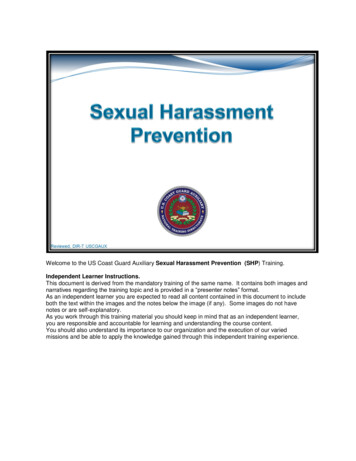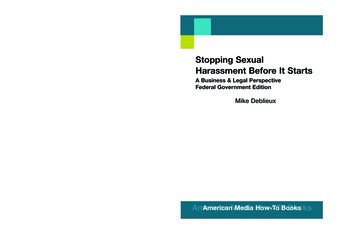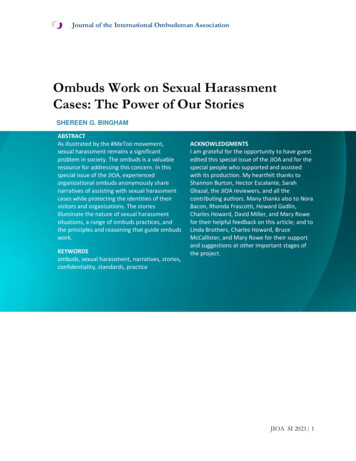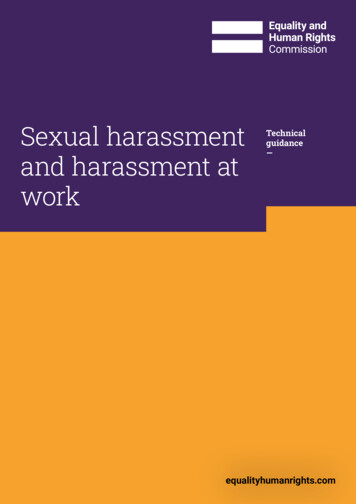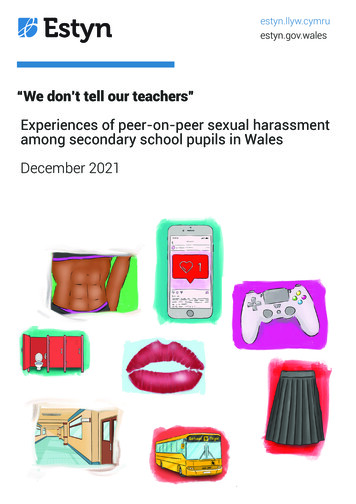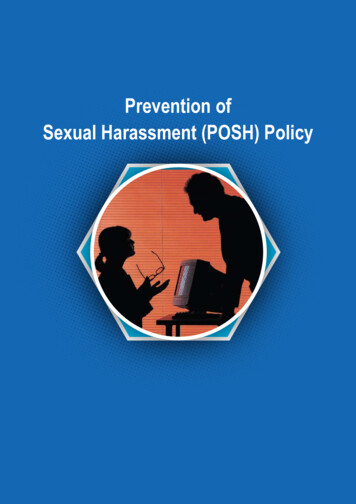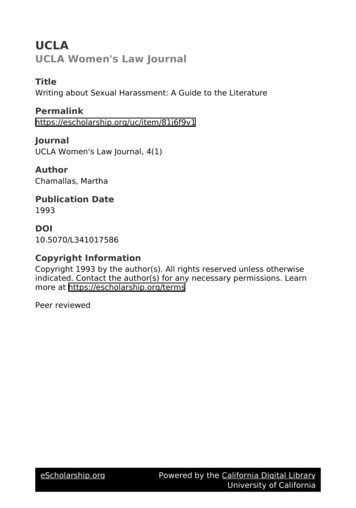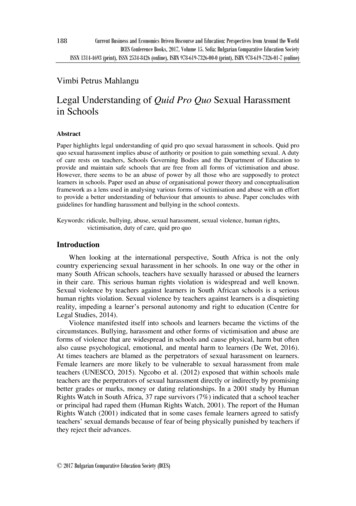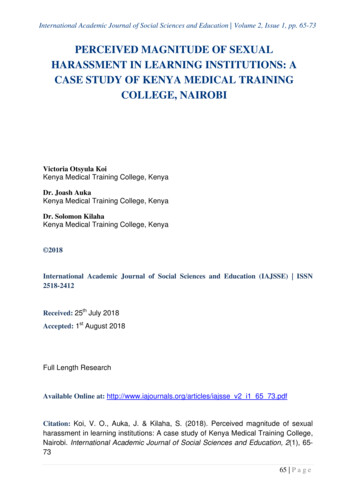
Transcription
International Academic Journal of Social Sciences and Education Volume 2, Issue 1, pp. 65-73PERCEIVED MAGNITUDE OF SEXUALHARASSMENT IN LEARNING INSTITUTIONS: ACASE STUDY OF KENYA MEDICAL TRAININGCOLLEGE, NAIROBIVictoria Otsyula KoiKenya Medical Training College, KenyaDr. Joash AukaKenya Medical Training College, KenyaDr. Solomon KilahaKenya Medical Training College, Kenya 2018International Academic Journal of Social Sciences and Education (IAJSSE) ISSN2518-2412Received: 25th July 2018Accepted: 1st August 2018Full Length ResearchAvailable Online at: http://www.iajournals.org/articles/iajsse v2 i1 65 73.pdfCitation: Koi, V. O., Auka, J. & Kilaha, S. (2018). Perceived magnitude of sexualharassment in learning institutions: A case study of Kenya Medical Training College,Nairobi. International Academic Journal of Social Sciences and Education, 2(1), 657365 P a g e
International Academic Journal of Social Sciences and Education Volume 2, Issue 1, pp. 65-73ABSTRACTHarassment is any form of behaviorwhether verbal, non-verbal, or physicalthat embarrasses a person. It takes theform of sexual harassment, racial,personal, bullying, age and Stalkingamong others. Sexual harassment istherefore unwanted coercion for sexualfavors. Although legislation, disciplinaryand grievance procedures have beenamended to deal with the issue in theworkplace, this remains a hidden problemwhich warrants the need for a study toestablish sexual harassment in learninginstitutions. The study adopted adescriptive research design. KenyaMedical Training College, Nairobi waschosen as the area of study with studentsand staff being the target population. Thepopulation was stratified into staff andstudents. Students’ stratum was furtherstratified into 3 substrata (1st, 2nd, and 3rdyears). The staff was further stratified into2 substrata (teaching and non-teaching).The respondents were selected randomlyfrom the substrata. The sample for thestudy was made up of 356 respondents.Questionnaires were used to collect datawhich was coded for analysis using SPSS.Both descriptive and inferential statisticswere analyzed. The quantitative data wasinterpreted in charts, tables, and graphswhile qualitative data was presented indescriptive narration. Strict confidentialitywas maintained throughout the study tomaintain ethical concerns. The findingsshowed that (57%) of the student’srespondents have never experienced anyform of sexual harassment while, (43%)have experienced some forms of sexualharassment that range from physical,verbal and non-verbal sexual violence.From the total number of students, 34%are aware of where to report any case ofSexual Harassment, whereas 66% are notaware of where to report any case ofSexual Harassment. The findings indicatedthat 73% of the staff have neverexperienced any form of sexualharassmentwhereas27%haveexperienced some type of sexualharassment that ranges from physical,verbal and non-verbal sexual violence.38% of the staff were aware of where toreport any case of Sexual Harassmentwhereas 52% are not aware of where toreport any case of Sexual Harassment.Key Words: Sexual harassment, Sexualforms, learning institutions, KenyaMedical Training CollegeINTRODUCTIONAccording to Stanko (2012), refers to sexual harassment as unwanted sexual attention whichmay take several forms including; visual, verbal, unwanted pressure for sexual favors,unwanted touching and pinching, physical assault, sexual assault, and rape. Victims of sexualharassment may be men or women. However, research by Flax (2012), stated that often insexual harassment situations, women are normally the victims while men are the harassers.Sexual harassment is increasing in learning institutions. Research by Erulkar (2004), andRuto and Chege (2006) conclude that 24% of sexual harassment occur in learninginstitutions. Studies show that women and girls are the likely victims of sexual harassment incomparison to boys and girls. Research by Erulkar (2004), Mbassa (2001), and Ruto and66 P a g e
International Academic Journal of Social Sciences and Education Volume 2, Issue 1, pp. 65-73Chege (2006) conclude the students are the main perpetrators of sexual harassment in schoolsfollowing adults. Ruto and Chege (2006), concluded that Mwingi District out of 12 districtshad the highest complains and incidents of sexual harassment. The study indicated that 60%of girls and 56% of boys were victims of sexual harassment. In support of Swartz (1998), thestudy reported that students with disabilities were the most vulnerable to sexual violence.Terefe and Mengistu (1997), documented that high drop-out rates and low enrolment insecondary schools in Ethiopia were caused by sexual harassment and bullying. A study byMbassa (2001), indicated that 16% of the 1688 surveyed students in Sub-Saharan Africa inCameroon were victims of sexual harassment. 38% of the 422 girls interviewed in Botswanaadmitted to being sexually harassed (Mbassa, 2001). Lee et al. (1996) documents that sexualharassment affects academics, psychology, and behavior negatively. These, in turn, bringineffectiveness in performance in schools. In spite of these extensive researches, littleinvestigative attention has been paid to sexual harassment of teachers in either special needsor regular schools. Experience, formal and informal reports have shown that the female andmale teachers in regular boys and girls boarding secondary schools respectively may befacing various forms of sexual harassment. For instance, students who have undergone ritesof initiation/passage have been reported to view young teachers as their equals and try toexercise power over them, sometimes of sexual nature (Ruto & Chege, 2006). There isevidence of sexual harassment in learning institutions. Colleges and universities have beenaccused of promoting “sex for grades” phenomena where some lecturers have harassedfemale students when the students fail to submit to the lecturers” sexual demands. Thus theneed to research on sexual harassment at Kenya Medical Training College.PROBLEM STATEMENTSexual harassment in the workplace has been shrouded in silence, and there have been veryfew credible studies to date of problems affecting employees in the developing world(Williams, 2012). Sexual harassment in the workplace affects performance negativelyresulting in high turnover, absenteeism, low productivity, increased complaints, and legalexpenses (Glomb, 2007). A lot of research on sexual harassment in the workplace has beenundertaken. Research by Glombo (2007), concluded that many sexual harassment cases inthe workplace go unreported. The study suggests that the cases are not reported despite theavailability of legislation and procedures in organizations to deal with sexual harassmentcases. Anderson and Umberson (2001), explain that the most rampant cases of sexualharassment are in Pakistan, Thailand, Canada, and India. According to Collins (2010), 20%of 1837 women surveyed in China admitted to sexual harassment experience in theworkplace. Julian (2008), documented that any sexual behavior at work was not acceptableby employees of a hospital in India. The study concluded that although inappropriate sexualbehavior was unacceptable, it did happen in the hospital. Research by Wasilwa (2012),concluded that sexual harassment was perceived by employees as a way of gaining trust fromsupervisors paving the way for promotions. The study also reported on incidents of anxiety,embarrassment, and unproductivity as a result of sexual harassment in the workplace.Previous studies have mainly viewed sexual harassment in organizations from theperspective of the employees as victims of sexual harassment and have mainly been67 P a g e
International Academic Journal of Social Sciences and Education Volume 2, Issue 1, pp. 65-73conducted in regular organizations. The perspective of student and staff as victims of sexualharassment in schools has not been widely researched. Yet, achievement of schooleffectiveness demands, among others, a secure environment for students and staff, which inturn impacts positively on performance which warrants the need for the study to establish thesexual harassment in learning institutions in Kenya Medical Training Colleges, Nairobi.GENERAL OBJECTIVEThe main aim was to study the perceived magnitude of sexual harassment in learninginstitutions, a case study of Medical Training Colleges, Nairobi, Kenya.THEORETICAL REVIEWThe Social Structure TheorySocial structure theory is based on factors of social-economic stratification of the society(Merton, 1968). Violence is evident in lower social economic stratus who face manytribulations. The theory explains that states personality issues arise from poverty, illiteracy,infidelity, stress, unemployment, and isolation which are disadvantages faced by lower socialeconomic status. In support of Merton (1968), Coser (1967), observes that the response bymany individuals with lower social-economic status is through violence. Gender-BasedViolence (GBV) is attributed to the structure of a specific society. Thus learning institutionsform a unique group with different frustrations and tribulations. The reason is that learninginstitutions are made up of students and staff from different socio-economic strata. Machera(2006), states that the social structure theory is suitable in explaining the forms of violenceexperienced in Kenyan media.The Feminist TheoryFeminist theory focusses on dominance and oppression and positions allocated to men andwomen within a society (Ruth, 1998). Patriarchal dominance is the root cause of genderbased violence in the society with respect to the feminist theory. The theory states that sexualharassment is observed as a way of maintaining patriarchy where the men benefit fromwomen subordination (Connell, 1987). Ruth (1998), documents that a patriarchal societyencourages male power, subordination by women, and inequality, thus, promoting sexualharassment.Sexual violence is social oppression against women since, the society expects women to beinferior to men, and thus, women are not awarded equal rights and powers in the society(McCue, 2008). The feminist theory perceives sexual harassment as a system. The theorysuggests that as long as equality is not practiced in both genders, sexual harassment willremain to be a societal problem. The society has established men to be powerful and womento be submissive. Following the tradition, girls at a tender age learn to be submissive victimswhile boys become the perpetrators.68 P a g e
International Academic Journal of Social Sciences and Education Volume 2, Issue 1, pp. 65-73EMPIRICAL REVIEWSexual HarassmentAccording to Stanko (2012), sexual harassment is unwanted sexual behavior that can beeither physical, verbal, or nonverbal. According to Stanko (2012), men support their behaviorof sexual violence through power. Men in many organizations hold positions of power,hence, can fire a woman for refusing to submit sexually. Sexual harassment can affect bothmen and women, however, according to Flax (2012), men are usually the perpetrators whilewomen are the victims in most cases.Sexual harassment can either be quid pro quo or sexual harassment. Quid pro quo where aperson holding a powerful position suggests sexual favors. Quid pro quo relates to exchangefor favors between two people, one of whom has the power to hire, promote, or fire thevictim. Sexual harassment refers to inappropriate sexual behavior leading to discomfortsexual harassment is often vied as a ‘grey area’ (Dansky, 2012), since many people do nottalk about it. Sexual harassment range from being trivial to extremely offensive. Till (2010),suggested that sexual harassment was divided into five; Gender harassment refers to sexuallyoffensive jokes made in terms of gender. Seductive behavior involves inappropriate behaviorleading to sexual favors such as flirtation. Sexual bribery, coercion, and imposition involvethreats made in exchange for sexual favors. Gruber (2012), categorized sexual harassmentinto three; verbal requests, comments, and non-verbal displays. Harassment using electricalmeans is on the rise. The reason is that many people are using electrical devices. Thepercentage of men and women using the internet is 68% and 66% respectively (LeClaire,2013). A study by Khoo and Senn’s (2014) found that women find most sexually suggestiveemails to be more offensive in comparison to men who find them enjoyable. Thus, gender isvital is identifying the perception of men and women concerning emails (Russell, 2012).Factors Contributing to Sexual HarassmentThe causes of sexual harassment are explained theoretically using four models; the natural,organizational, social-cultural, and sex role spill over the model. The natural model is basedon the assumption that human sexuality is extended in the workplace, thus leading to sexualharassment. The model’s ideology is that the strong sexual drive of men makes themaggressive at work since they are attracted to women (Tangri & Hayes, 2007). Theorganizational model assumes that the hierarchical power in the workplace leads to sexualviolence. The sociocultural model indicates that sexual harassment is encouraged by the maledominance in the society (Sczesny, 2007). The sex-role spillover model attributes sexualharassment to the character expected of women and men in the workplace. The modeldocuments that women are perceived as sexual while men as asexual.RESEARCH METHODOLOGYThe study adopted a descriptive research design the target population of the study was 356students and staff from KMTC. Stratified sampling was adopted to categorize the targetpopulation into two strata. Open and closed-ended questionnaires were used to collect69 P a g e
International Academic Journal of Social Sciences and Education Volume 2, Issue 1, pp. 65-73primary data. The response rate was 249 (99.3%) students and 25 (60%) staff. The responserate was above average with respect to the minimum threshold of 30% suggested by Kothari(2004). The data was entered into Microsoft Excel and later transferred to SPSS for analysis.After analysis, the qualitative findings were presented in descriptive narration while thequantitative data were interpreted using table, graphs, and charts.RESEARCH RESULTSStudent Sexual HarassmentThe study shows that (57%) of the student’s respondents’ have never experienced any formof sexual harassment while, (43%) have experienced some forms that range from physicalsexual violence, verbal and non-verbal sexual violence. From the responses 41.3% of thestudent respondents have experienced verbal sexual Harassment, 37.5% of the studentrespondents have experienced non- verbal sexual harassment, and finally, 21.2% haveexperienced physical sexual Harassment. This agreed with a study by Erulkar (2004), andRuto and Chege (2006), which indicates the existence of sexual harassment in learninginstitutions and Johnstone (2003) showed that 24% of sexual harassment took place in schoollearning settings.Responses on the Physical Forms of Sexual Harassment showed the experiences of Sexualassault (e.g. rape), (15.9%) of the students reported that they had such an experience.However, the majority (84.1%) of the students had no experience. The forms commonlyexperienced were 32.2% having had their body parts touched without their consent, while67.8% the majority, had not experienced sexual touch without their consent (consented) andon forceful kissing, 33.7% of the respondents had experienced it, while, the majority (66.3%)of students had not experienced.For the Non-Verbal Forms of Sexual Harassment most of the students 61% have neverreceived e-mails that had explicit sexual messages, 51% of the students had not experienceddisplay of sexual gestures like finger signs or winking, 55% of the students reported that theyhave never experienced sexual/pornographic materials (including magazines with nudepictures) being displayed for them to see without their consent and finally 53% of thestudents had experienced exposure of body parts that are to be kept private.Unwelcome sexual advances, Harassment via phone: It was established in the study thatthere was harassment via phone calls. 47.5% of the students indicated that they had receivedphone calls that were sexually insulting while 52.5% of the female teachers had notexperienced the same. Rumor about lifestyle: 49.8% of students responded that they hadheard rumors being spread about their purported sexual lives whereas 50.2% disagreedFinally, the Verbal Forms of Sexual Harassment, A bigger fraction of the students (55.5%)had experienced unwelcome sexual suggestions, comments and advances. On the contrary, abigger fraction (52.5%) of the female students had not experienced harassment via phonecalls. 50.2% of the students disagreed that they had heard rumors being spread about theirpurported sexual lives. Finally, 54.5% of students had been victims of Whistling and making70 P a g e
International Academic Journal of Social Sciences and Education Volume 2, Issue 1, pp. 65-73sexual sounds form of sexual harassment. Finally, 59.3% of the students reported to havebeen victims of insulting jokes that had sexual connotations.Female fellow students in college were the greatest perpetrators of physical form of Sexualharassment (36.7%), the greatest perpetrators of verbal form of Sexual harassment (37.2%)and also were the greatest perpetrators of Non-verbal Forms of Sexual Harassment (45.4%).Class rooms (62%) are the safest places in terms of sexual harassment which is followed bythe hostels (53%) then staff quarters (51%), playfields (37%) and finally on the way to andfrom college (26.5%). Whereas on the way to and from college is always unsafe place(17.1%), followed by the play fields (10.9%) then staff quarters (9.2%), hostels (8.3%) andfinally classroom (5.1%) is safe. From the total number of the students, 34% are aware ofwhere to report any case of Sexual Harassment whereas 66% are not aware of where toreport any case of Sexual Harassment. This implies that majority of the respondents are notaware of where to report any case of sexual harassment.Assessing the effects of sexual harassments on students 44.7% said it affected academicsvery much while 21.7% reported a bit, and 33.6% perceived that it did not affect themacademically. Students admitted to sexual harassment affecting them socially. 32.6% verymuch, 37.1% a bit, and 30.3% perceived that it did not affect them socially. The students alsoreported some psychological effects. Its effects on psychology were as follows, 44.5%perceived that sexual harassment affected them very much, 27.7% a bit and finally 27.7%perceived that it did not affect them. The results were similar to Lee et al. (1996), concludedthat sexual harassment affects negatively on academics, psychology, and behavior.Staff Sexual HarassmentA greater fraction of the staff (73%) have never experienced any form of sexual harassmentwhereas 27% have experienced varying forms of sexual harassment that range from physicalsexual violence, verbal and non-verbal sexual violence. Physical sexual Harassment (41%) isthe most common form of sexual harassment experienced by the staff whereas, non-verbalsexual Harassment (30.9%) is the second most common form of sexual harassmentexperienced by the staff and finally, verbal sexual Harassment (28%) is the least commonform of sexual harassment experienced by the staff. Female students in college (53%) werethe greatest perpetrators of Sexual harassment followed by the male fellow staff in college(19%). Thereafter Male students and departmental heads (14%) respectively. Of the totalnumber of the staff, 38% are aware of where to report any case of Sexual Harassmentwhereas 52% are not aware of where to report any case of Sexual Harassment implying that amajority of the staff are not aware of where to report any case of Sexual Harassment.CONCLUSIONSStudent Sexual HarassmentA greater fraction of the students have never experienced any form of sexual harassment. Forthose that have experienced sexual harassment, the common form is verbal followed by non-71 P a g e
International Academic Journal of Social Sciences and Education Volume 2, Issue 1, pp. 65-73verbal, and physical sexual violence. A bigger proportion of the students are not aware ofwhere to report any case of Sexual HarassmentStaff Sexual HarassmentA greater fraction of the staff has never experienced any form of sexual harassment. Physicalsexual harassment is the most common form of violence experienced by staff followed bynon-verbal and verbal violence respectively. Of the total number of the staff, the majority ofthem are not aware of where to report any case of Sexual Harassment.RECOMMENDATIONSThe researcher recommended the establishment of trust and understanding between thestudents and teachers at Kenya Medical Training College to prevent episodes of sexualharassment in the institution. Another recommendation was the establishment of a task forceof joint efforts to formulate gender relations policy spelling out regulations and cross-referralsystems between the KMTC and law enforcement agents. Lastly, establishment of a genderrelations office at the KMTC headquarters that shall coordinate all sexual harassment orgender discrimination in the institution.REFERENCESAnderson, K. L., & Umberson, D. (2001). Gendering violence: Masculinity and power inmen's accounts of domestic violence. Gender & society, 15(3), 358-380.Collins, E. G., & Blodgett, T. B. (2010). Sexual harassment. some see it. some won't.Harvard business review, 59(2), 76-95.Connell, K. (1987). Intersectionality as buzzword A sociology of science perspective on whatmakes a feminist theory successful. Feminist theory, 9(1), 67-85.Coser, N. (1967). Social capital: A theory of social structure and action (Vol. 19). Cambridgeuniversity press.Dansky, B. S., & Kilpatrick, D. G. (2012). Effects of sexual harassment.Eruklar, C. L., Fitzgerald, L. F., & Drasgow, F. (2004). Organizational influences on sexualharassment. Sage Publications, Inc.Flax, J. (2012). Postmodernism and gender relations in feminist theory. Signs, 12(4), 621643.Glomb, T. M., Richman, W. L., Hulin, C. L., Drasgow, F., Schneider, K. T., &Johnson, L. F.(2007). Ambient sexual harassment: An integrated model of antecedents andconsequences. Organizational Behavior and Human Decision Processes, 71(3),309-328.Gruber, R., & Hermle, L. C. (2012). Sexual harassment in the workplace. TNT AudioProductions.Julian, J. P. (2008). The perception of employees regarding sexual harassment at a businessunit of public utility (Doctoral dissertation).Khoo, H. E., & Senns, M. S. (2014). Sexual harassment in the workplace. Journal ofVocational Behavior, 42(1), 1-4.72 P a g e
International Academic Journal of Social Sciences and Education Volume 2, Issue 1, pp. 65-73Kothari, C. R. (2004). Research methodology: methods and techniques, (2nded.). New Delhi.New Age International (P) LimitedLeClaire, D. E., & Skaine, R. (2013). Sexual harassment in the workplace. Social Work,28(5), 385-390.Lee, M. S. (Ed.). (2006). Sexual harassment in the workplace: Perspectives, frontiers, andresponse strategies (Vol. 5). Sage Publications.Machera, R. L. (2006). Social learning and social structure: A general theory of crime anddeviance. Transaction Publishers.Mbassa, E., Carrera, J. S., Stratton, T., Bickel, J., & Nora, L. M. (2006). Experiences ofbelittlement and harassment and their correlates among medical students inCameroon: longitudinal survey. Bmj, 333(7570), 682.McCue, J. (2008). Performative acts and gender constitution: An essay in phenomenologyand feminist theory. Theatre Journal, 40(4), 519-531.Merton, R. K. (1968). Social theory and social structure. Simon and Schuster.Russell, D. E. (2012). Sexual Exploitation: Rape, child sexual abuse, and workplaceharassment.Ruth, I. M. (1998). Throwing like a girl and other essays in feminist philosophy and socialtheory.Ruto, B. A., & Chege, B. (2006). Sex‐ratios, sex‐role spillover, and sexual harassment ofwomen at work. Journal of Social Issues, 38(4), 55-74.Sczesny, J. A., Rospenda, K. M., Nawyn, S. J., Flaherty, J. A., Fendrich, M., Drum, M. L., &Johnson, T. P. (2007). Sexual harassment and generalized workplace abuseamong university employees: prevalence and mental health correlates.American Journal of Public Health, 89(3), 358-363.Stanko, S. G. (2012). The feminist standpoint theory reader: Intellectual and politicalcontroversies. Psychology Press.Swan, S., & Fitzgerald, L. F. (2011). Job-related and psychological effects of sexualharassment in the workplace: empirical evidence from two organizations.Journal of Applied Psychology, 82(3), 401.Swartz, M. H. (1998). Textbook of physical diagnosis: History and examination.Philadelphia: SaundersTangri, S. S., Burt, M. R., & Johnson, L. B. (1982). Sexual harassment at work: Threeexplanatory models. Journal of Social Issues, 38(4), 33-54.Terefe Jr, D. C., Daugherty, S. R., & Eckenfels, E. J. (2007). Student perceptions ofmistreatment and harassment during medical school. A survey of ten UnitedStates schools. Western Journal of Medicine, 155(2), 140.Till, A. P., & Gupta, M. (2010). Sexual harassment in the workplace. Editorial Board, 16.Wasilwa, G., (2012). Sexual Harassment of Women Employees at Kenyatta National.Williams, K. B. (2012). A social psychological model for predicting sexual harassment.Journal of Social Issues, 51(1), 69-84.73 P a g e
sexual harassment in learning institutions in Kenya Medical Training Colleges, Nairobi. . Men in many organizations hold positions of power, hence, can fire a woman for refusing to submit sexually. Sexual harassment can affect both men and women, however, according to Flax (2012), men are usually the perpetrators while .

